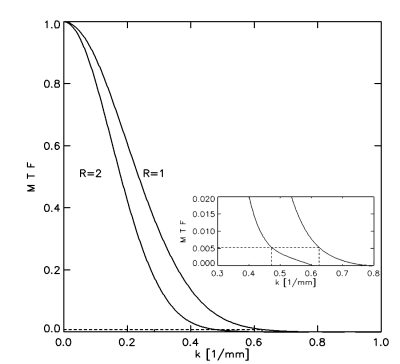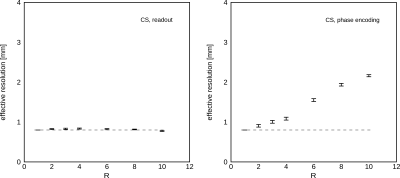Milica Medved1, Marco Vicari2, and Gregory S Karczmar1
1Department of Radiology, The University of Chicago, Chicago, IL, United States, 2Fraunhofer MEVIS, Bremen, Germany
1Department of Radiology, The University of Chicago, Chicago, IL, United States, 2Fraunhofer MEVIS, Bremen, Germany
Compressed sensing (CS) acceleration factors of up to 4 are a realistic
option for high spectral and spatial resolution (HiSS) MRI, potentially expanding
its application and increasing its diagnostic utility.

Figure 2: Modulation transfer
functions in the phase encoding direction are shown for acceleration factors R =
1 and R = 2 on CS-reconstructed HiSS MRI data. At k = 0.625 1/mm (corresponding to in-plane
resolution of 0.8 mm), the value of MTF at R = 1 is 0.0053. For R = 2, this MTF value corresponds to k = 0.48
(see inset), or an equivalent resolution of 1.05 mm.

Figure 4: The spatial resolution
in the readout (left), and phase encoding (right) direction is shown as a
function of the compressed sensing (CS) acceleration factor R, with nominal
resolution at R =1 set to 0.8 mm in-plane.
There is no noticeable degradation of spatial resolution in the readout
direction, even at very high acceleration factors. The spatial resolution in the phase encoding
direction is adversely affected for acceleration factors R ≥ 6.
